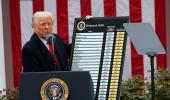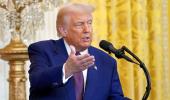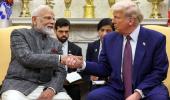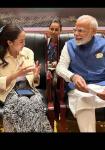The executive order on reciprocal tariffs signed by United States President Donald Trump highlights the duties charged by India on American products.

Trump signed the executive order titled ‘Regulating Imports with a Reciprocal Tariff to Rectify Trade Practices that Contribute to Large and Persistent Annual United States Goods Trade Deficits' in the White House's Rose Garden on Wednesday, describing it as “Liberation Day” and 2 April 2025 as the day “American industry was reborn.”
The executive order mentions the tariffs charged by India on US products. A fact sheet issued by the White House on reciprocal tariffs also includes similar tariffs that India imposes on US goods.
“…while World Trade Organisation (WTO) members agreed to bind their tariff rates on a most-favoured-nation (MFN) basis, and thereby provide their best tariff rates to all WTO members, they did not agree to bind their tariff rates at similarly low levels or to apply tariff rates on a reciprocal basis.
“Consequently, according to the WTO, the United States has among the lowest simple average MFN tariff rates in the world at 3.3 per cent, while many of our key trading partners like Brazil (11.2 per cent), China (7.5 per cent), the European Union (EU) (5 per cent), India (17 per cent), and Vietnam (9.4 per cent) have simple average MFN tariff rates that are significantly higher,” the executive order stated.
It added that these average MFN tariff rates conceal much larger discrepancies across economies in tariff rates applied to particular products.
“For example, the United States imposes a 2.5 per cent tariff on passenger vehicle imports (with internal combustion engines), while the European Union (10 per cent), India (70 per cent), and China (15 per cent) impose much higher duties on the same product. For network switches and routers, the United States imposes a 0 per cent tariff, but for similar products, India (10 per cent) levies a higher rate.
“Brazil (18 per cent) and Indonesia (30 per cent) impose a higher tariff on ethanol than does the United States (2.5 per cent). For rice in the husk, the US MFN tariff is 2.7 per cent (ad valorem equivalent), while India (80 per cent), Malaysia (40 per cent), and Turkey (an average of 31 per cent) impose higher rates. Apples enter the United States duty-free, but not so in Turkey (60.3 per cent) and India (50 per cent),” the executive order stated.
Trump announced a 26 per cent “discounted reciprocal tariff” on India, half of the 52 per cent levies imposed by India on American goods, as he described India as “very, very tough.”
In his nearly hour-long remarks on a cold Wednesday late afternoon in the Rose Garden, Trump listed various countries from around the world and the tariffs they charge on US products, saying, “For decades, our country has been looted, pillaged, raped, and plundered by nations near and far, both friends and foes alike. American steelworkers, autoworkers, farmers, and skilled craftsmen… they really suffered gravely. They watched in anguish as foreign leaders stole our jobs. Foreign cheaters ransacked our factories, and foreign scavengers tore apart our once-beautiful American dream.”
As he announced the tariffs, Trump held up a chart showing the tariffs that countries such as India, China, the European Union, Japan, Taiwan, South Korea, Bangladesh, Sri Lanka, and Pakistan levy on US products and the reciprocal levies that these countries will now have to pay.
On India, the chart showed that the country charged 52 per cent tariffs to the US “including currency manipulation and trade barriers,” and America will now charge India “discounted reciprocal tariffs” of 26 per cent.
“India, very, very tough. Very, very tough. The Prime Minister just left. He's a great friend of mine, but I said, ‘You're a friend of mine, but you're not treating us right.' They charge us 52%. You have to understand, we charge them almost nothing, for years and years and decades, and it was only seven years ago, when I came in, that we started with China and we took in hundreds of billions of dollars from China in tariffs,” Trump said.
Prime Minister Narendra Modi had visited Washington DC in February, less than a month after Trump took the oath of office and began his second term in the White House as President.
The executive order stated that Trump finds that “underlying conditions, including a lack of reciprocity in our bilateral trade relationships, disparate tariff rates and non-tariff barriers, and US trading partners' economic policies that suppress domestic wages and consumption, as indicated by large and persistent annual US goods trade deficits, constitute an unusual and extraordinary threat to the national security and economy of the United States.
“That threat has its source in whole or substantial part outside the United States in the domestic economic policies of key trading partners and structural imbalances in the global trading system. I hereby declare a national emergency with respect to this threat,” Trump said in the order.
The executive order notes that despite a commitment to the principle of reciprocity, the trading relationship between the United States and its trading partners has become “highly unbalanced, particularly in recent years.”
“The post-war international economic system was based upon three incorrect assumptions: first, that if the United States led the world in liberalising tariff and non-tariff barriers, the rest of the world would follow; second, that such liberalisation would ultimately result in more economic convergence and increased domestic consumption among US trading partners converging towards the share in the United States; and third, that as a result, the United States would not accrue large and persistent goods trade deficits.”
Describing 2 April 2025 as “Liberation Day,” Trump announced reciprocal tariffs of varying degrees on 185 nations. Trump imposed a 10 per cent tariff on all countries, which will take effect from 5 April 2025.
The order stated that Trump will impose an individualised reciprocal higher tariff on the countries with which the United States has the largest trade deficits. All other countries will continue to be subject to the original 10% tariff baseline, which will take effect from 9 April 2025.










 © 2025
© 2025